Shoulder Tendonitis and Impingement
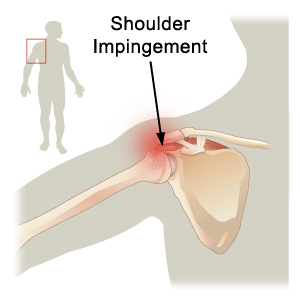
Tendonitis is an inflammation of the shoulder tendons. The signs of inflammation are pain, warmth, redness, tenderness to touch, and loss of function. Shoulder tendonitis (often called Rotator Cuff Tendonitis) can occur when the rotator cuff is overloaded, fatigued, traumatized, and with age-related degenerative changes. Pinching or impingement of the rotator cuff tendons occurs in a region under a bony structure called the acromion (the projection of the shoulder blade that forms the tip of the shoulder). Impingement happens when the arm is raised overhead repeatedly, or raised overhead with a heavy load in your hand, or may occur when you sleep on your shoulder. X-rays may show a hook or spur that increases the odds that you will pinch the rotator cuff tendons.
Treatment for impingement or rotator cuff tendonitis usually involves rest, anti-inflammatory medications like ibuprofen, physical therapy to restore proper strength and movement, and less often, a cortisone injection.
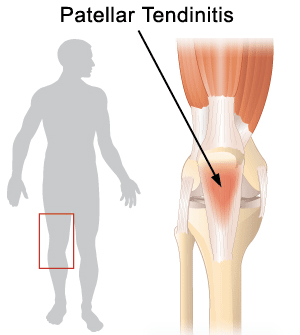
Patellar Tendinitis (Jumper’s Knee)
Jumping sports (such as basketball and volleyball) put a huge load on the kneecap and attached tendons. Signs and symptoms of patellar tendonitis include pain to touch directly on the patellar tendon and occasionally, swelling. Treatment includes activity modification, and physical therapy.
Sinding-Larsen-Johansson is a specific disorder of the patellar tendon where it attaches to the base of the kneecap. In contrast, Osgood-Schlatter disease is a disorder of the tendon where it attaches at the tibial tuberosity of the leg. Both are common disorders in maturing teens. Treatment includes activity modification, physical therapy, and rarely surgical excision of the associated necrotic debris.
Achilles Tendonitis and Rupture
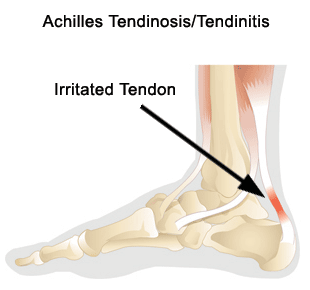
The Achilles tendon attaches the calf muscle (called the gastrocnemius and soleus muscles) to the heel. Excessive stress or a tight or fatigued calf muscle can result in microtrauma, degeneration, and even inflammation of the tendon- a condition called Achilles Tendonitis/Tendinosis. Prolonged walking, overtraining (excessive running or jumping, or walking hills can cause this condition.
Recent research suggests that a gradual onset of pain and prolonged recovery might be due to a similar condition called Achilles tendinosis. Tendinosis is chronic degenerative condition and it differs from tendonitis in that there is no inflammation present. It is probably more common than tendinitis because often times tendon pain is not accompanied by the classic inflammatory signs of swelling, redness, and warmth.
Treatment usually consists of rest, non-steroidal anti-inflammatory drugs (NSAIDs), ice, stretching, strengthening and progressive return to function or sport.
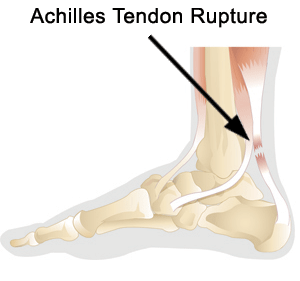
Forceful contraction of the calf muscle may rupture (completely tear) the Achilles tendon. It occurs during jumping, running, and cutting and is often seen in basketball and baseball players. The patient often reports the sensation of having been hit or violently kicked in the lower calf. There is pain and a “divot” in the tendon above the heel.
Treatment- non-surgical rehabilitation and surgical repair are viable treatment options. Active people may experience more benefit from surgical repair. Rehabilitation may require six to twelve months of progressive care.
Tibialis Posterior Tendonitis
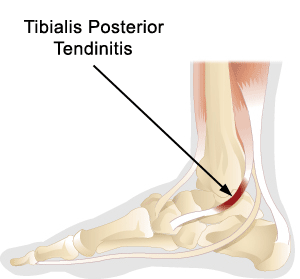
This often occurs in overweight, middle aged women and men as a result of degenerative changes in the tendon. The rupture may be partial or complete with pain below or behind the inside ankle bone (medial malleolus). A flattened arch is common. Anti-inflammatory treatment (physical therapy modalities), orthoses, and surgical debridement are common treatments.
